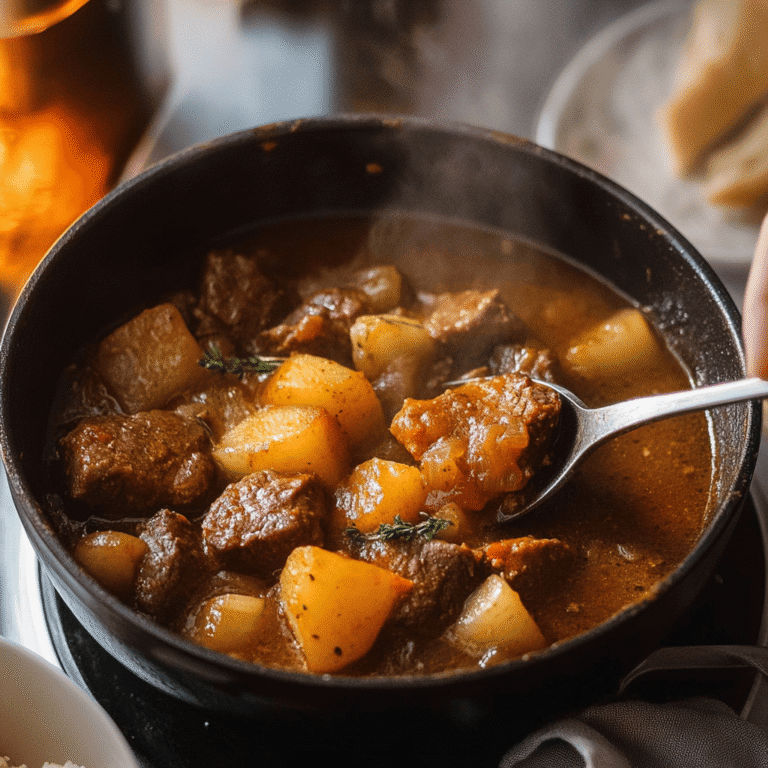There’s nothing worse than making a beef stew that just doesn’t hit the mark. You know, the kind of stew that tastes a little… bland. If you’ve ever been there, you’re not alone. But fear not! The secret to a mouthwatering beef stew lies in the stew meat seasoning. A perfectly seasoned stew can take you from “meh” to “wow” with just a few simple adjustments, and I’m here to guide you through it.
So, how do you season bland beef stew? The key is balance. When it comes to stew meat seasoning, it’s all about the right blend of herbs, spices, and flavors to elevate the natural taste of the beef and create a stew that’s bursting with flavor. Let’s dive into how to transform your stew into a comforting masterpiece.
How to Season Bland Beef Stew?
If you’ve ever tasted a beef stew that lacked flavor, it’s likely that the seasoning didn’t have enough depth or the right combination. Here’s how you can fix it and season your beef stew to perfection:
- Start with a flavorful base: Season your stew meat with salt and pepper first, then let it brown to develop deep flavors. This simple step is the foundation of your stew’s taste.
- Layer in the spices: The real magic happens when you add spices like garlic powder, onion powder, and thyme. These spices not only enhance the beef but also make the broth savory and aromatic.
- Balance with acidity: A splash of vinegar or a squeeze of lemon at the end of cooking brightens up the rich flavors and adds a touch of freshness.
- Add umami: For a richer flavor profile, incorporate ingredients like soy sauce, Worcestershire sauce, or even a dash of tomato paste. These umami-rich ingredients will give your stew that depth you’re craving.
- Simmer long enough: The longer your stew simmers, the more the seasoning will infuse into the meat. Give it time — a stew isn’t a rush job!
With these tips, you’ll take your bland stew and make it something you’ll be proud to serve.
Why This Stew Meat Seasoning Will Become Your Go-To
The beauty of this stew meat seasoning is that it’s simple yet full of flavor. You don’t need a long list of complicated ingredients — just the basics that you likely have in your pantry already. Here’s why you’ll love it:
- It’s easy to make: This seasoning doesn’t require fancy or expensive ingredients. It’s all about common spices like thyme, garlic powder, and black pepper.
- It enhances the natural flavors of the beef: The seasoning is designed to bring out the best in your beef stew, without overpowering it. You’ll still taste the meat, but with a lovely depth of flavor.
- You can customize it: Feel free to tweak the seasoning to suit your family’s preferences. Add more heat with a pinch of cayenne or swap out thyme for rosemary — it’s all about making it your own!
For even more ways to elevate your beef stew, check out The Best Homemade Beef Stew Seasoning Recipe for a rich and delicious twist.
Practical Tips / Cooking Tips
Here are a few additional tips to make your stew meat seasoning shine:
- Brown the meat first: Before adding any liquid, brown your stew meat in a hot pan. This caramelization gives your beef a rich, savory flavor that forms the base of your stew.
- Don’t rush the simmer: Slow cooking is key. Let your stew simmer for at least 1-2 hours to fully develop the flavors.
- Taste as you go: After the stew has been cooking for a while, taste it and adjust the seasoning. Add salt, pepper, or additional spices as needed.
- Add herbs last: Fresh herbs like parsley or thyme should be added toward the end of cooking so that they don’t lose their flavor during the simmer.
Nutritional Value / Health Benefits
In addition to making your beef stew flavorful, this stew meat seasoning can be packed with health benefits:
| Nutrient | Amount | % Daily Value |
|---|---|---|
| Calories | 15 | 1% |
| Protein | 1g | 2% |
| Fiber | 1g | 4% |
| Iron | 1mg | 5% |
- Iron Boost: Iron-rich ingredients like thyme and garlic help boost your energy and promote healthy circulation.
- Antioxidants: Garlic and onion powder are known for their antioxidant properties, helping to fight inflammation and support overall health.
- Flavor without guilt: This seasoning is naturally low in calories and free from artificial additives, making it a healthy choice for your stew.

Recipe Overview
Transform your bland beef stew into a delicious, comforting meal with this stew meat seasoning. Here’s a quick rundown of the steps:
- Season your stew meat with salt, pepper, and this flavorful seasoning mix.
- Brown the meat to develop a rich flavor.
- Add your broth and let the stew simmer for 1-2 hours, letting the seasoning infuse into the meat and broth.
It’s that simple! And the best part? You’ll have a stew that’s packed with flavor, ready to serve your family in no time.
Ingredients
Here’s what you’ll need to make this flavorful stew meat seasoning:
| Ingredient | Quantity | Substitute Option |
|---|---|---|
| Onion Powder | 2 tbsp | Shallot Powder |
| Garlic Powder | 1 tbsp | Fresh Garlic (minced) |
| Dried Thyme | 1 tbsp | Dried Rosemary |
| Dried Bay Leaves | 2 leaves | Ground Bay Leaf |
| Salt | 1 tsp | Kosher Salt |
| Black Pepper | 1 tsp | White Pepper |
| Paprika | 1 tsp | Smoked Paprika |
Instructions
- Combine the spices: In a small bowl, mix together the onion powder, garlic powder, dried thyme, bay leaves, salt, black pepper, and paprika.
- Brown the meat: Heat a pan over medium-high heat and brown the stew meat until it’s golden and crisp on all sides. This step will add richness to the stew.
- Add the seasoning: Once the meat is browned, sprinkle your stew meat seasoning over it and stir to coat. Add your broth and vegetables.
- Simmer and serve: Let the stew simmer for 1-2 hours, stirring occasionally. Taste and adjust the seasoning as needed.
FAQs
Can I substitute any of the ingredients in this seasoning recipe?
Yes! If you don’t have dried thyme, rosemary works wonderfully. You can also use fresh garlic instead of garlic powder — just sauté it with the meat at the beginning.
How do I store leftovers of the beef stew?
Store any leftover beef stew in an airtight container in the fridge for up to 3 days. You can also freeze it for up to 3 months for those days when you don’t want to cook!
Conclusion
This stew meat seasoning is the key to a flavorful, comforting beef stew that’s perfect for any night of the week. Quick, easy, and full of savory depth, this seasoning will elevate your stew every time. Whether you’re a beginner or an experienced cook, this simple yet delicious seasoning is all you need for a stew that’s anything but bland.
Print
5 Stew Meat Seasoning Tips: Transform Your Stew with Flavorful Blends
- Total Time: 25 minutes
- Yield: Makes enough seasoning for 4-6 servings of beef stew
Description
This stew meat seasoning is your secret to a flavorful, comforting beef stew. Quick, easy, and delicious, this seasoning will elevate your stew every time.
Ingredients
Onion Powder: Shallot Powder
Garlic Powder: 1 tbsp
Dried Thyme: 1 tbsp
Dried Bay Leaves: 2 leaves
Salt: 1 tsp
Black Pepper: 1 tsp
Paprika: 1 tsp
Instructions
- Combine the spices: In a small bowl, mix together the onion powder, garlic powder, dried thyme, bay leaves, salt, black pepper, and paprika.
- Brown the meat: Heat a pan over medium-high heat and brown the stew meat until it’s golden and crisp on all sides. This step will add richness to the stew.
- Add the seasoning: Once the meat is browned, sprinkle your stew meat seasoning over it and stir to coat. Add your broth and let the stew simmer for 1-2 hours.
- Simmer and serve: Let the stew cook, allowing the seasoning to infuse into the meat. Stir occasionally and taste to adjust the seasoning before serving.
Notes
- If you like a bit of heat, add cayenne pepper or smoked paprika for extra kick.
- Use fresh thyme and rosemary for a deeper, more vibrant flavor.
- Prep Time: 5 minutes
- Cook Time: 20 minutes
- Category: Seasoning, Main Dish
- Method: Mixing
- Cuisine: American
Nutrition
- Serving Size: 1 tablespoon of seasoning
- Calories: 20
- Sugar: 0
- Sodium: 250mg
- Fat: 0
- Saturated Fat: 0
- Unsaturated Fat: 0
- Trans Fat: 0
- Carbohydrates: 5g
- Fiber: 1g
- Protein: 1g
- Cholesterol: 0







